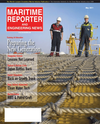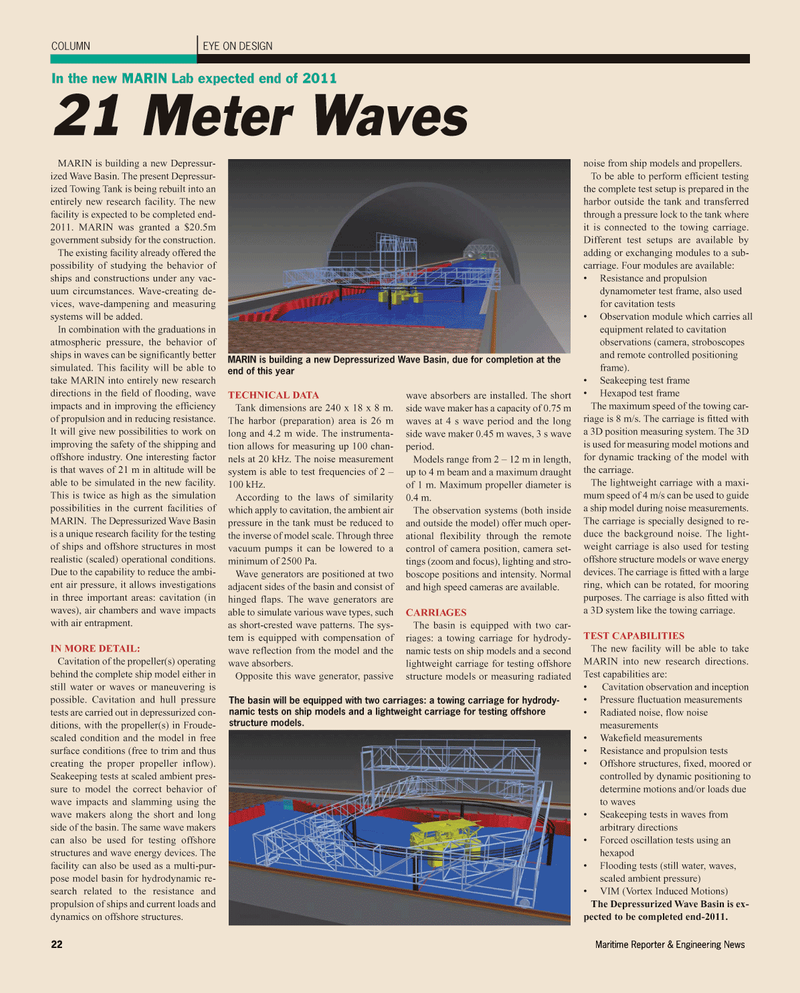
Page 22: of Maritime Reporter Magazine (May 2011)
Training & Education Edition
Read this page in Pdf, Flash or Html5 edition of May 2011 Maritime Reporter Magazine
22 Maritime Reporter & Engineering News
COLUMN EYE ON DESIGN
In the new MARIN Lab expected end of 2011 21 Meter Waves
MARIN is building a new Depressur- ized Wave Basin. The present Depressur- ized Towing Tank is being rebuilt into an entirely new research facility. The new facility is expected to be completed end- 2011. MARIN was granted a $20.5m government subsidy for the construction.
The existing facility already offered the possibility of studying the behavior of ships and constructions under any vac- uum circumstances. Wave-creating de- vices, wave-dampening and measuring systems will be added.
In combination with the graduations in atmospheric pressure, the behavior of ships in waves can be significantly better simulated. This facility will be able to take MARIN into entirely new research directions in the field of flooding, wave impacts and in improving the efficiency of propulsion and in reducing resistance.
It will give new possibilities to work on improving the safety of the shipping and offshore industry. One interesting factor is that waves of 21 m in altitude will be able to be simulated in the new facility.
This is twice as high as the simulation possibilities in the current facilities of
MARIN. The Depressurized Wave Basin is a unique research facility for the testing of ships and offshore structures in most realistic (scaled) operational conditions.
Due to the capability to reduce the ambi- ent air pressure, it allows investigations in three important areas: cavitation (in waves), air chambers and wave impacts with air entrapment.
IN MORE DETAIL:
Cavitation of the propeller(s) operating behind the complete ship model either in still water or waves or maneuvering is possible. Cavitation and hull pressure tests are carried out in depressurized con- ditions, with the propeller(s) in Froude- scaled condition and the model in free surface conditions (free to trim and thus creating the proper propeller inflow).
Seakeeping tests at scaled ambient pres- sure to model the correct behavior of wave impacts and slamming using the wave makers along the short and long side of the basin. The same wave makers can also be used for testing offshore structures and wave energy devices. The facility can also be used as a multi-pur- pose model basin for hydrodynamic re- search related to the resistance and propulsion of ships and current loads and dynamics on offshore structures.
TECHNICAL DATA
Tank dimensions are 240 x 18 x 8 m.
The harbor (preparation) area is 26 m long and 4.2 m wide. The instrumenta- tion allows for measuring up 100 chan- nels at 20 kHz. The noise measurement system is able to test frequencies of 2 – 100 kHz.
According to the laws of similarity which apply to cavitation, the ambient air pressure in the tank must be reduced to the inverse of model scale. Through three vacuum pumps it can be lowered to a minimum of 2500 Pa.
Wave generators are positioned at two adjacent sides of the basin and consist of hinged flaps. The wave generators are able to simulate various wave types, such as short-crested wave patterns. The sys- tem is equipped with compensation of wave reflection from the model and the wave absorbers.
Opposite this wave generator, passive wave absorbers are installed. The short side wave maker has a capacity of 0.75 m waves at 4 s wave period and the long side wave maker 0.45 m waves, 3 s wave period.
Models range from 2 – 12 m in length, up to 4 m beam and a maximum draught of 1 m. Maximum propeller diameter is 0.4 m.
The observation systems (both inside and outside the model) offer much oper- ational flexibility through the remote control of camera position, camera set- tings (zoom and focus), lighting and stro- boscope positions and intensity. Normal and high speed cameras are available.
CARRIAGES
The basin is equipped with two car- riages: a towing carriage for hydrody- namic tests on ship models and a second lightweight carriage for testing offshore structure models or measuring radiated noise from ship models and propellers.
To be able to perform efficient testing the complete test setup is prepared in the harbor outside the tank and transferred through a pressure lock to the tank where it is connected to the towing carriage.
Different test setups are available by adding or exchanging modules to a sub- carriage. Four modules are available: • Resistance and propulsion dynamometer test frame, also used for cavitation tests • Observation module which carries all equipment related to cavitation observations (camera, stroboscopes and remote controlled positioning frame). • Seakeeping test frame • Hexapod test frame
The maximum speed of the towing car- riage is 8 m/s. The carriage is fitted with a 3D position measuring system. The 3D is used for measuring model motions and for dynamic tracking of the model with the carriage.
The lightweight carriage with a maxi- mum speed of 4 m/s can be used to guide a ship model during noise measurements.
The carriage is specially designed to re- duce the background noise. The light- weight carriage is also used for testing offshore structure models or wave energy devices. The carriage is fitted with a large ring, which can be rotated, for mooring purposes. The carriage is also fitted with a 3D system like the towing carriage.
TEST CAPABILITIES
The new facility will be able to take
MARIN into new research directions.
Test capabilities are: • Cavitation observation and inception • Pressure fluctuation measurements • Radiated noise, flow noise measurements • Wakefield measurements • Resistance and propulsion tests • Offshore structures, fixed, moored or controlled by dynamic positioning to determine motions and/or loads due to waves • Seakeeping tests in waves from arbitrary directions • Forced oscillation tests using an hexapod • Flooding tests (still water, waves, scaled ambient pressure) • VIM (Vortex Induced Motions)
The Depressurized Wave Basin is ex- pected to be completed end-2011.
MARIN is building a new Depressurized Wave Basin, due for completion at the end of this year
The basin will be equipped with two carriages: a towing carriage for hydrody- namic tests on ship models and a lightweight carriage for testing offshore structure models.

 21
21

 23
23
